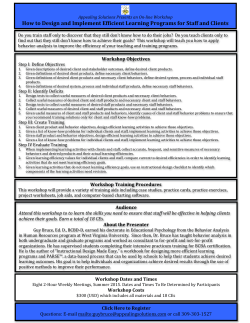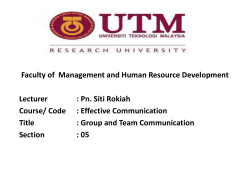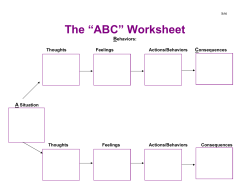
Document 230300
Practice Matters — How to motivate your staff Helping your staff achieve successful results starts with setting appropriate goals. By Cathy Urquhart, MS, MSN, RN “UGGHH, I DON’T WANT TO,” Melissa whines. “Do I have to? Right now? Can’t it wait?” “Sure, I can help,” says Carrie. “What would you like me to do? When do you need me to do it?” What motivates some people to want to do something and others to resist doing it? Why do some jump at the chance to help while others drag their feet or offer their help only after the task is done? Why are some people motivated to do wonderful work and others to avoid work? Motivation is the state or condition of being motivated, or moved to action; the term is synonymous with incentive or drive. Behaviorists define motivation as anticipation of or participation in getting something you want. To put it simply, people do what they do because of the rewards they gain from doing those things. People who whine get others to do their work for them. Over the years, they’ve learned they can’t do anything right or fast enough. They whine, which irritates you; to get them to stop whining, you do the work for them. Set your staff up for success Fortunately, most people want to succeed. And success breeds success. People who don’t know how to succeed eventually learn how to get others to do their work. They’re motivated to whine so as to avoid failure. On the other hand, people who know how to achieve results are motivated by the satisfaction they get from their success; they want to get that feeling as often as possible. Success motivates them. They’ve learned how to produce successful results and become experts in their specialty area. By learning a process or using a formula to achieve success, you can help yourself and your staff achieve goals and succeed. Build empowering relationships The key to setting staff members up for success is to www.AmericanNurseToday.com build empowering relationships that provide them with the experiences they need to develop the skills required to achieve goals. Talk with your staff and ask questions so you can learn what’s important to them, determine their current skill levels, and find out about their goals and values. Set achievable goals and results Once you know a person’s goals, values, and skill level, you can work with him or her to develop a plan with achievable goals, and to provide reinforcement and rewards in line with what that person wants. Keep in mind that goals and results need to be measurable so staff members know when they’ve met the criteria for success. Generally, goals are measured with numbers, whereas results are measured through judgment. Examples of measurable goals for nurses are chart audits showing compliance with specific criteria, such as discharge planning and timely medication administration. Examples of desired results are building a cohesive team or using good nursing judgment. Provide as many criteria as possible for gauging goal achievement. Checklists are useful in tracking criteria. If creating a cohesive team is the result you want to achieve, you need to define what behaviors by team members signify this result, and then track those behaviors. Examples of such behaviors include: • sharing knowledge and expertise • offering and accepting assistance for difficult tasks • sharing successes • acknowledging each other’s achievements. Desired behaviors need to be shaped in a way that enables the person to succeed right from the start. Discuss with your staff which behaviors they currently exhibit and which ones they’ll need to learn. Begin with July/August 2009 American Nurse Today 27 the most basic behaviors and progress to more complex ones. Remember—any behavior exhibited is an attempt at performance. If performance falls short of desired behavior, the effort should be reinforced. But be sure to take one small step at a time. People vary in the amount of practice they need to achieve a desired performance level. As Yoda said, “Do or do not, there is no try.” Trying implies failure. Start staff members at their current level of performance and success, and build on that. Provide appropriate support Assess what your staff members need to achieve the goals and behaviors identified. Nurses’ experiences with anticipatory guidance helps us anticipate support needs. Examples of needed support are additional training, time to practice skills, technology equipment or training, and financial support. By anticipating what support your staff might need and discussing it with them, you’re showing your support for their success. Being there for them helps build the foundation for loyalty through trust. How did the process FARE? Use the mnemonic FARE to evaluate the success of an endeavor. Be sure everyone involved in the process gets an opportunity to offer input. eelings come first; they must be processed before the process can be objectively evaluated. Are the results exciting, disappointing, or somewhere in between? ctions come second. By reviewing the actions or behaviors exhibited, you and your team can learn and move forward. Review how the team got to the end point and whether the endeavor was a complete success, a dismal failure, or something in between. ate the Results. On a scale of 1 to 5, how well do the results meet the stated goal? valuate the rating given in the preceding step. Are the results acceptable given the circumstances—especially any unforeseen circumstances that arose? Are they beyond what was expected? Or were they totally unacceptable? F A R E Next, ask yourself or staff members these questions: • What would you do the same way the next time? • What would you do differently? Asking this question gives you and your staff the chance to correct gaps in planning and helps them overcome unanticipated obstacles. • What would you do if …? Using this open-ended question, your team can brainstorm how to overcome obstacles. A team member with more experience may anticipate a problem that a less-experienced person wouldn’t foresee; by asking pertinent questions, you help them see possible consequences. When people gain insight by solving problems, they’re more likely to remember and use the solution. Reinforce desired behaviors Use pictorial graphs with pertinent data to show staff members their progress. Graphs and data are objective indicators of success; they’re worth a thousand words. They allow team members to share what they’re doing to achieve results. Explain the data and graphs to reinforce the process and to gain status for implementing changes and showing improvement. Knowing they’re performing an action more efficiently motivates staff to continue the behavior and spurs them on to even greater accomplishments. Reinforce the graphs and data with personal notes or conversations that specify how the person’s behavior has affected the outcome for both that person and the team as a whole. This supplies the “Wow! I really made a difference!” factor, which has a long-lasting impact. Evaluate the process We can improve on nearly everything—but only if we take the time to examine what we’ve done and brainstorm innovations for the future. When reviewing an experience, we examine goals, actions, support, and reinforcement; then we can decide what to repeat, 28 American Nurse Today Volume 4, Number 7 what to avoid, and what to do differently in the future. (See How did the process FARE?) Reward results When your staff achieves desired goals and results, reward them by giving them what they want. People are motivated to act when they anticipate or participate in getting something they want. Commemorate goal achievement with a significant event, such as a dinner or an awards ceremony. This will help your staff relive and remember how the goal was achieved. Emotions related to success become motivators for future success. Motivational speaker Zig Ziglar once said, “You can have everything you want in life if you’ll just help enough other people get what they want.” People are motivated to achieve when they know how to achieve. When you teach people a process for achieving the goals and results they want, you’ll hear them ask, “What can I do to help?” much more often. ✯ Cathy Urquhart is the president of Performance Health, a management consulting firm in Andover, Massachusetts. www.AmericanNurseToday.com
© Copyright 2025





















